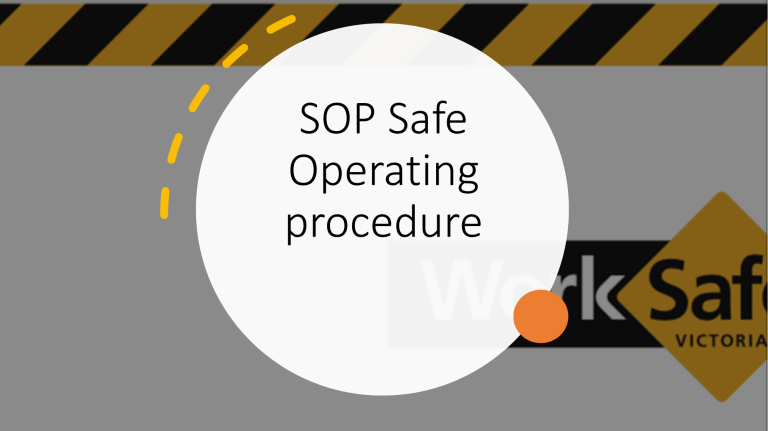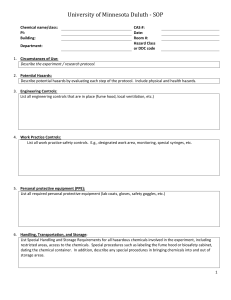
SOP Safe Operating procedure APK Question • 1. What is a Safe Operating Procedure? • A safe operating procedure (SOP) is a written document that provides step-bystep instructions on how to safely perform a task or activity which involves some risk to health and safety. A safe operating procedure is sometimes referred to as a safe work procedure or safe work method statement. Learning GOAL: When do I need a Safe Operating Procedure? Safe operating procedures may need to be developed as a risk control measure: • When indicated from the outcomes of a risk assessment carried out in accordance with legislative requirements to identify hazards and manage risks to health and safety; • When introducing new work practices; • When introducing new equipment / technology; or • Following on from a workplace inspection, either internal or external (i.e. regulatory inspection). Risk Management / Task ? 3. Risk Management As a safe operating procedure is a risk control measure designed to ensure the health and safety of workers and others. The first step in developing a safe operating procedure is to conduct an assessment of the task. This involves the use of a Job Safety Analysis (JSA), sometimes referred to as a Job Safety Environment Analysis (JSEA), Task Hazard Analysis (THA), or Job Hazard Analysis (JHA) • Content of a Safe Operating Procedure A safe operating procedure should include: • The task / process to be undertaken; • Details of any legislative requirements that are appropriate and have been considered in the safe operating procedure, e.g. for high risk tasks, forklift operations, confined space entry, hot works, etc.; • Definitions of any specialised or unusual terms; • Specific information regarding the potential hazards and associated risks of the task; • Precautions required to eliminate or adequately control the risk prior to commencing the task, such as isolation procedures, ensuring guarding is in place, communication procedures, etc.; • Personal protective equipment (PPE) required to be worn while undertaking the task, (this includes site standard personal protective equipment); • The environment where the task shall or should be undertaken; • Clear and simple instructions for undertaking the task in a safe manner; • Correct environmental, cleanup and waste disposal measures, this will require referring to any appropriate safety data sheets (SDSs); • Emergency procedures; and • Shutdown and housekeeping. Each safe operating procedure must be dated and assigned a document control number, a version number, an issue date, a review date and detail the document owner and approver. • 5. How to prepare a Safe Operating Procedure Safe operating procedures should be written using plain English and must be set out in a concise, logical, step-by-step, easy-to-read format. The use of photos or diagrams may assist with this process. Reference to the manufacturer’s or supplier’s user manuals or information may be required to assist in providing accurate information. The safe operating procedure should be written and developed in consultation with workers (inclusive of any elected Health and Safety Representatives HSRs) and others involved in the task. The Steps • 5.1. Sequence of job steps Break down the task or operation into the basic steps to complete the work task and / or operate the item of plant / equipment. For example, what is done first, what is done next and so on. Record each step of the task in the order of normal sequence, making sure you describe what is done, not how it is done. As a working guide, the task description should be contained within approximately 10 broad steps. This of course may vary depending on the complexity and the hazardous nature of the job. Risks • 5.2. Potential hazards / risks For each step in the work task, list the potential hazards / risks that are reasonably foreseeable. This may include, but is not limited to: • Being struck by or contacted by anything; • Striking against or contacting anything; • Being caught in, on, under or between anything; • Falling from height or being exposed to falling objects; • Hazardous manual tasks; • Being exposed to welding rays, fumes, light, electricity or other forms of energy; • Being exposed to stored energy; or • Being exposed to hazardous chemicals. Control measures • 5.3. Recommended control measures For each step in the work task, list the most appropriate risk control measure that will eliminate or minimise the risk to the person(s) completing the work task. For each potential hazard / risk, identify and list the steps of how the work task is to be completed, including what the operator(s) should or should not do to manage the level of risk. Specifically describe the safe operating procedure and precautions that must be taken for each step. Attach any appropriate information or references. A safe operating procedure may reference other safe operating procedures. PPE • 5.4. Personal Protective Equipment (PPE) List the types of Personal Protective Equipment that is required to be used whilst undertaking the task. Note: This includes site standard Personal Protective Equipment. Perform the task • Perform the task Test the written procedure by carrying out the task in accordance with the documented safe operating procedure, completing the following checks: • Inspect the task again; • Check the upstream and downstream tasks that may have an impact; • Seek improvement to the work method; • Consider all hazards at each step; • Ensure understanding in the work group or an individual worker of the hazards associated with each step of the procedure; and • Reassess and modify the safe operating procedure, as required. Note: Each time the safe operating procedure is modified a new version shall need to be recorded. Task • Write a SOP safe operating procedure for using one of the following hand tools or power tools • Cutting using a tenon saw with a bench hook • Drilling a hole in a piece of wood using a cordless drill • Using a pedestal drill • Using a spot welder • Using a Jig saw Tasks in woodwork, Metalwork and Textiles Tasks in Food Tec 1 Pedestal Drill 1. Using Hot oil 2 Sewing machine 2. Using a hot oven 3 3.Chopping 4 4. Removing hot pans from the oven Tasks in Stem and In the table in the next slidencreate a ‘SOP’ for the INSERT TOOL HERE - Identify each phase - State three safety checks for each phase. - Use the document Titled SOP Safety glasses must be worn at all times in work areas. Sturdy footwear must be worn at all times in work areas. Long and loose hair must be contained. Gloves must not be worn. Close fitting/protective clothing must be worn. Rings and jewellery must not be worn. PREOPERATI ONAL SAFETY CHECKS Locate and ensure you are familiar with all machine operatio ns and controls. Ensure all guards


